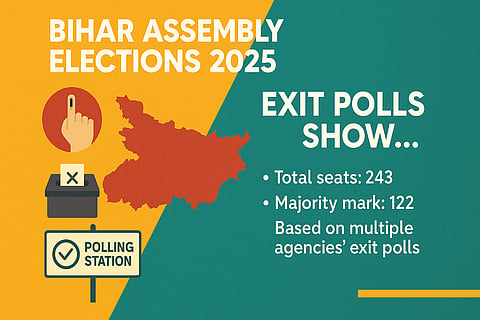

The high-stakes Bihar Assembly elections grabbed everyone’s attention—not just for the record turnout, but for what the exit polls are saying. Most surveys point to a strong comeback for the National Democratic Alliance (NDA). When the results of Exit Polls from all major survey agencies are combined—a classic "Poll of Polls"—the message stands out. This outcome gives the NDA real momentum as they look forward to upcoming state and national contests. On the other side, the Mahagathbandhan (MGB)—led by the Rashtriya Janata Dal (RJD) and its young face, Tejashwi Yadav—doesn’t seem to have cleared the majority hurdle. Their campaign focused hard on jobs and the promise of change, but the numbers just aren’t there. Meanwhile, Prashant Kishor’s Jan Suraaj Party (JSP) has barely registered. Most projections put them in the single digits, if that.
Numerical Sweep: Exit Polls Data Breakdown
Let’s look at the numbers. Exit polls say the NDA will win decisively, easily crossing the 122-seat majority in the 243-member assembly. The “Poll of Polls” average puts the NDA around 148 seats. ‘Matrize’ saw them between 147 and 167; MGB, 70 to 90. ‘Dainik Bhaskar’ gave the NDA 145–160 and the MGB 73–91. ‘P-Marq’ had the NDA at 142–162, MGB at 80–98. ‘People’s Pulse’ forecast 133–159 for the NDA and 75–101 for MGB. ‘JVC Poll’ went with 135–150 for the NDA, 88–103 for MGB. Even ‘Chanakya Strategies’—more generous to the opposition—still had NDA ahead (130–138), with the MGB trailing at 100–108. So, the consensus is clear. The MGB, under RJD, will likely finish far behind, with an average of about 88 seats. As for the JSP, most pollsters expect them to win anywhere from zero to a handful of seats—no real impact.
Decoding the Voter Mood: Four Factors for NDA’s Edge
What’s driving this NDA edge? If these predictions hold, it means voters in Bihar favoured stability and government delivery over dramatic promises. Four main factors stand out. First, the “Mahila” factor. This election saw turnout jump to about 67.14%, led by women. For over a decade, women in Bihar have emerged as a key voting bloc, often casting their ballots differently from the men in their families. The NDA government has worked to win their support—think free bicycles and uniforms for girls, reservations for women in local government, prohibition, and finally the ‘Jeevika Didi’ scheme, cash transfers for women-led households. These programs have built real loyalty and a sense of partnership with the government. This time, the old “MY” (Muslim-Yadav) equation gave way to “Mahila-Yuva,” and the exit polls say women voters swung to the ruling alliance.
Second, the jobs issue. The MGB put unemployment front and center, promising a fixed number of government jobs—a powerful message in a state where young people face high unemployment and many leave for work. But this pitch didn’t land with voters, especially the youth. Many doubted the RJD’s ability to deliver, pointing to the party’s earlier time in power—the so-called “Jungle Raj”—even as Tejashwi Yadav tried to give the party a fresh start.
The NDA pushed back hard against its critics, pointing to its steady progress—better law and order, ongoing development, and the reliable rollout of central welfare programs like free rations, housing, and toilets. For many in the rural poor, these existing benefits felt more tangible and secure than the uncertain promise of new jobs down the road.
BJP’s Unbroken Social Engineering
The NDA's victory formula relies heavily on the consolidation of multiple social groups. The alliance successfully stitched together its core base. BJP’s approach to winning elections hasn’t changed much. It’s all about bringing together a mix of social groups and holding on to its base. The BJP zeroes in on upper castes, plus a big chunk of non-Yadav OBCs and non-Jatav SCs. National leaders connect with these groups, reinforcing their support. Over the past twenty years, the NDA has paid special attention to the EBCs and Mahadalits, making sure these communities see clear benefits. Exit polls show their loyalty hasn’t wavered—they stuck with the NDA, recognizing its commitment to uplifting them. Unity within the NDA, especially with regional allies like Chirag Paswan’s Lok Janshakti Party (Ram Vilas), proved critical. Together, they managed to counter the MGB’s heavy focus on the Muslim-Yadav alliance, drawing in support from a wider range of castes.
Opposition's Campaign and Internal Struggles
The Mahagathbandhan’s campaign ended in disappointment. Tejashwi Yadav carried much of the weight, bringing energy to the campaign, but the alliance still struggled. Disputes over seat-sharing and internal conflicts among the RJD, Congress, and Left parties watered down their message. The RJD’s troubled legacy still lingers, especially for the middle class and young, educated voters who care about stability and safety. Congress, too, couldn’t deliver—its chronic failure to transfer its limited votes to its partners, especially when it mattered most, remained a major hurdle the MGB never solved.
